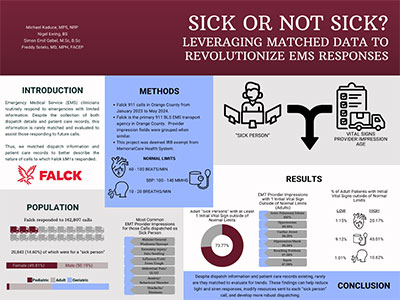ABSTRACTS
Sick or Not Sick? Leveraging Matched Data to Revolutionize EMS ResponsesAuthor: Michael Kaduce, Nigel Ewing, Simon Emil Gøbel, and Freddy Sotelo | | Associate Authors:
Introduction: Emergency medical services (EMS) personnel routinely respond to emergencies with limited information. Despite the collection of both dispatch details and patient care records, this information is rarely matched and evaluated to assist those responding to future calls. Objective: To match dispatch information and patient care records to better describe the nature of calls to which Falck emergency medical technicians (EMTs) respond. Methods: Descriptive statistics were generated for Falck 9-1-1 calls in Orange County from January 2023 to May 2024 that dispatch defined as a “sick person.” Falck is the primary 9-1-1 BLS EMS transport agency in Orange County. Inclusion criteria included “sick person” calls with associated provider impressions. Provider impression fields were grouped when similar. Patient demographics, provider impression, heart rate, respiratory rate, and systolic blood pressure were described. Normal adult vital signs were defined as heart rate 60–100 beats per minute, respiratory rate 10–20 breaths per minute, and systolic pressure 100–140 mm Hg. Results: Falck responded to 142,807 calls, 20,843 (14.60%) of which were for a “sick person.” Of these, 10,382 (49.81%) had a gender documented as female, 20,317 (97.48%) were older than 18 years, and 11,590 (55.6%) older than 65 years. Provider impressions are described in Table 1 and vital signs in Table 2. Of those older than 18 years, 14,987 (73.77%) had initial vital signs outside normal limits (Table 3). Conclusion: Despite the availability of dispatch information and patient care records, they are rarely matched to evaluate for trends. These findings can help reduce emergent responses, modify resources sent to each “sick person” call, and develop more robust dispatching.
|

